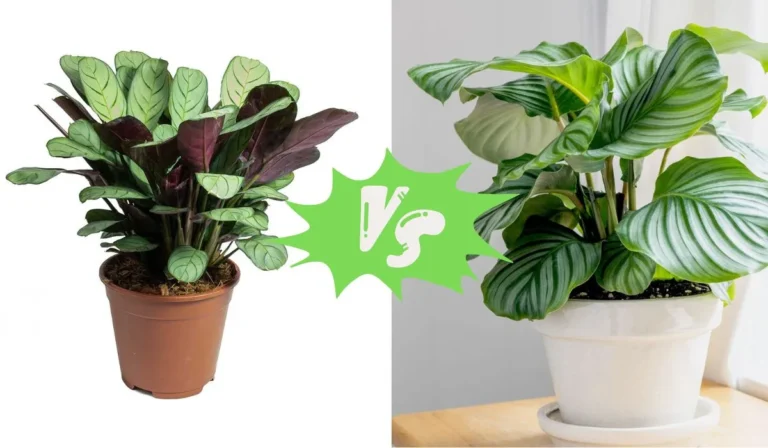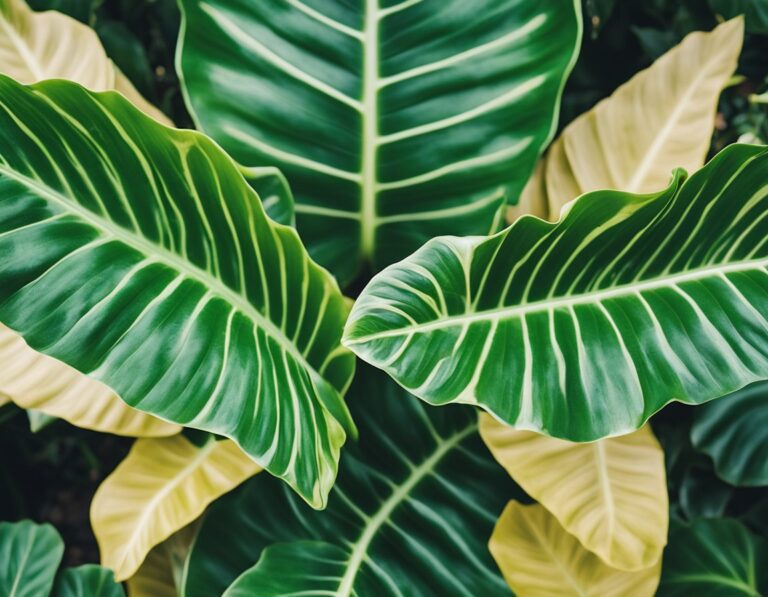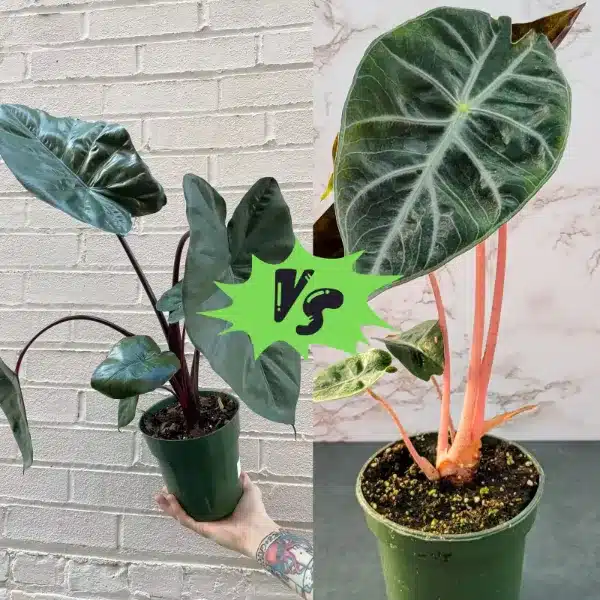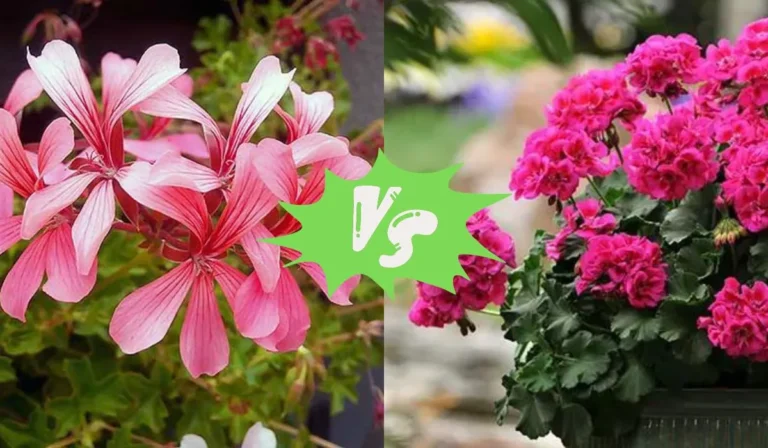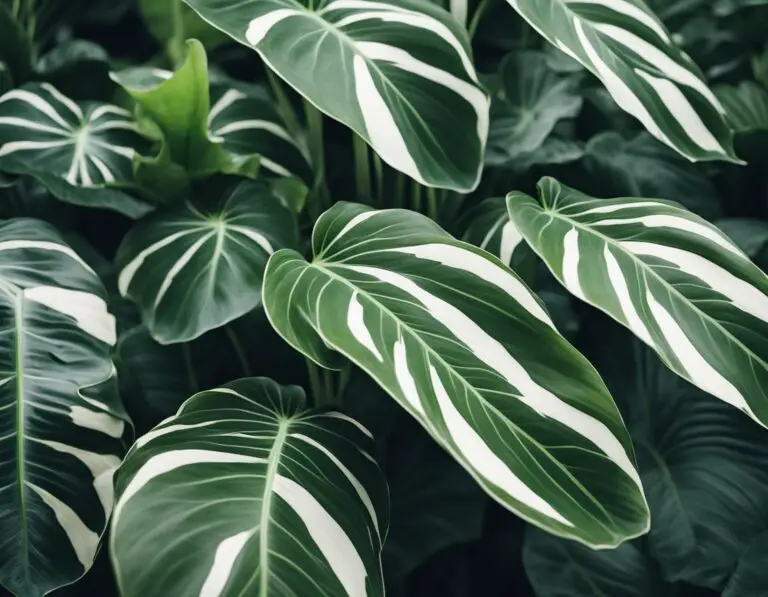Alocasia Imperial Red vs Pink Dragon: Which is the Best for Your Home?
If you’re a plant enthusiast, you’re probably familiar with Alocasia plants. These stunning plants are known for their large, heart-shaped leaves and can add a tropical touch to any indoor space.
Two popular varieties of Alocasia plants are the Imperial Red and Pink Dragon. In this article, we’ll compare and contrast these two plants and provide you with tips on how to care for them.

The Alocasia Imperial Red features large, dark green leaves with striking red undersides. On the other hand, the Alocasia Pink Dragon has green leaves with light pink veins. While both plants are beautiful, they have some differences in appearance and care requirements. In this article, we’ll explore these differences and help you determine which plant is right for you.
Key Takeaways
- Alocasia Imperial Red has dark green leaves with red undersides, while Alocasia Pink Dragon has green leaves with light pink veins.
- These plants have different care requirements, with Alocasia Pink Dragon needing more humidity and watering than Alocasia Imperial Red.
- Both plants can add a tropical touch to your indoor space and are great options for plant enthusiasts looking for a unique and eye-catching plant.
Alocasia Imperial Red Overview

Alocasia Imperial Red is a tropical plant that is native to Asia. It is a popular houseplant due to its striking foliage, which features large, arrow-shaped leaves that are dark green in color with bright red veins. The plant can grow up to three feet tall and requires bright, indirect light to thrive.
One of the key features of Alocasia Imperial Red is its preference for high humidity. The plant thrives in an environment of 70% humidity and above but will tolerate down to at least 50%. To keep your Alocasia Imperial Red happy, it is recommended to mist the leaves frequently or place a humidifier nearby.
When it comes to watering, Alocasia Imperial Red prefers consistently moist soil, but it is important not to overwater the plant as this can lead to root rot. It is recommended to water the plant when the top inch of soil feels dry to the touch.
Overall, Alocasia Imperial Red is a beautiful and relatively easy-to-care-for plant that can add a touch of tropical flair to your home. With proper care and attention, it can thrive for many years, bringing joy and beauty to your living space.
Alocasia Pink Dragon Overview

If you’re looking for a stunning houseplant that’s sure to impress, the Alocasia Pink Dragon is a great choice. This plant is known for its shiny dark green leaves and light pink stems, which make it a standout in any collection. While it can flower in the spring and summer months, the blooms are relatively insignificant compared to its magnificent foliage.
The Alocasia Pink Dragon can grow up to 5 feet tall, making it a great choice for those who want a larger plant. It prefers bright, indirect light and well-draining soil. Keep the soil moist but not waterlogged, and be sure to mist the leaves regularly to increase humidity.
One thing to keep in mind when caring for the Alocasia Pink Dragon is that it is toxic to pets and humans if ingested. So, be sure to keep it out of reach of children and pets. Overall, the Alocasia Pink Dragon is a beautiful and unique addition to any indoor plant collection.
Comparative Analysis
When it comes to choosing between Alocasia Imperial Red and Pink Dragon, there are several factors to consider. Both plants have similar care requirements, but there are some differences in their appearance and growth patterns.
Appearance: Alocasia Imperial Red has deep red stems and green leaves with red veins, while Pink Dragon has metallic-green leaves with silver veins and pink stems. Both plants have arrow-shaped leaves, but the color and pattern of the leaves are different.
Size: Alocasia Imperial Red can grow up to 3 feet tall, while Pink Dragon can reach up to 2 feet tall. If you have limited space, Pink Dragon might be a better choice for you.
Care: Both plants require bright, indirect light and moist soil. Alocasia Imperial Red is more sensitive to overwatering, so it’s important to let the soil dry out slightly between waterings. Pink Dragon is more tolerant of moisture, but it’s still important to avoid overwatering.
Propagation: Both plants can be propagated through division or stem cuttings. Alocasia Imperial Red can be slow to propagate, while Pink Dragon is more prolific.
In summary, both Alocasia Imperial Red and Pink Dragon are beautiful and unique plants that can add a touch of tropical elegance to your home. Your choice will ultimately depend on your personal preferences and the conditions in your home.
Caring Tips for Alocasia Plants
Alocasia plants are a great addition to any plant lover’s collection. They are known for their stunning foliage and unique shapes. However, they do require some specific care to thrive. Here are some tips to help you care for your Alocasia plants:
- Lighting: Alocasia plants prefer bright, indirect light. Direct sunlight can scorch their leaves, so it’s best to keep them away from windows that receive direct sunlight. If you notice that your Alocasia’s leaves are turning yellow, it may be receiving too much light.
- Watering: Alocasia plants like to be kept moist but not soggy. Allow the top inch of soil to dry out before watering again. Overwatering can lead to root rot, so be sure not to let your Alocasia sit in standing water.
- Humidity: Alocasia plants thrive in humid environments. If the air in your home is dry, you can increase the humidity around your Alocasia by placing a humidifier nearby or by placing a tray of water near the plant.
- Temperature: Alocasia plants prefer warm temperatures between 60-85°F (15-29°C). They do not like cold drafts or temperatures below 55°F (13°C).
- Fertilizing: Alocasia plants benefit from regular fertilization during the growing season. Use a balanced fertilizer every 2-3 weeks to promote healthy growth.
By following these tips, you can help your Alocasia plants thrive and enjoy their stunning foliage.
Frequently Asked Questions
What are the main differences in care requirements between Alocasia Imperial Red and Pink Dragon?
When it comes to care requirements, Alocasia Imperial Red and Pink Dragon have a lot in common. Both plants prefer bright, indirect light and well-draining soil. However, there are some differences in their care needs.
Alocasia Imperial Red requires more humidity than Pink Dragon, and it’s important to keep the soil consistently moist. On the other hand, Pink Dragon is more forgiving when it comes to watering and can tolerate slightly drier soil.
How do the sizes of Alocasia Imperial Red and Pink Dragon compare?
Alocasia Imperial Red and Pink Dragon are similar in size, with mature plants reaching around 2-3 feet in height. However, the leaves of Alocasia Imperial Red tend to be larger and wider than those of Pink Dragon.
Can Alocasia Imperial Red and Pink Dragon be grown indoors effectively?
Yes, both Alocasia Imperial Red and Pink Dragon can be grown indoors effectively. These plants are popular houseplants because they can thrive in bright, indirect light and are relatively low maintenance. However, it’s important to note that Alocasia plants can be toxic to pets and children, so it’s important to keep them out of reach.
What Alocasia varieties feature pink stems, and how do they differ from Pink Dragon?
In addition to Pink Dragon, there are several other Alocasia varieties that feature pink stems, including Alocasia Pink Princess and Alocasia Cuprea. While these plants may look similar at first glance, they have some key differences.
Alocasia Pink Princess has variegated leaves with pink and green coloring, while Alocasia Cuprea has metallic-looking leaves with a reddish-purple underside.
Is there a synonym for Alocasia Pink Dragon, and what makes it unique?
Yes, Alocasia Pink Dragon is also known as Alocasia Lowii ‘Morocco’. This plant is unique because of its striking foliage, which features dark green leaves and light pink stems. While it can produce small, insignificant flowers in the spring and summer, it’s really the leaves that make this plant so popular among houseplant enthusiasts.
Does the Alocasia Pink Dragon experience dormancy, and how should it be managed?
Alocasia Pink Dragon is not a plant that goes dormant, but it may slow down its growth during the winter months. During this time, it’s important to reduce watering and allow the soil to dry out slightly between waterings.
It’s also a good idea to reduce fertilization during this time. As the weather warms up and the days get longer, you can resume regular watering and fertilization.

